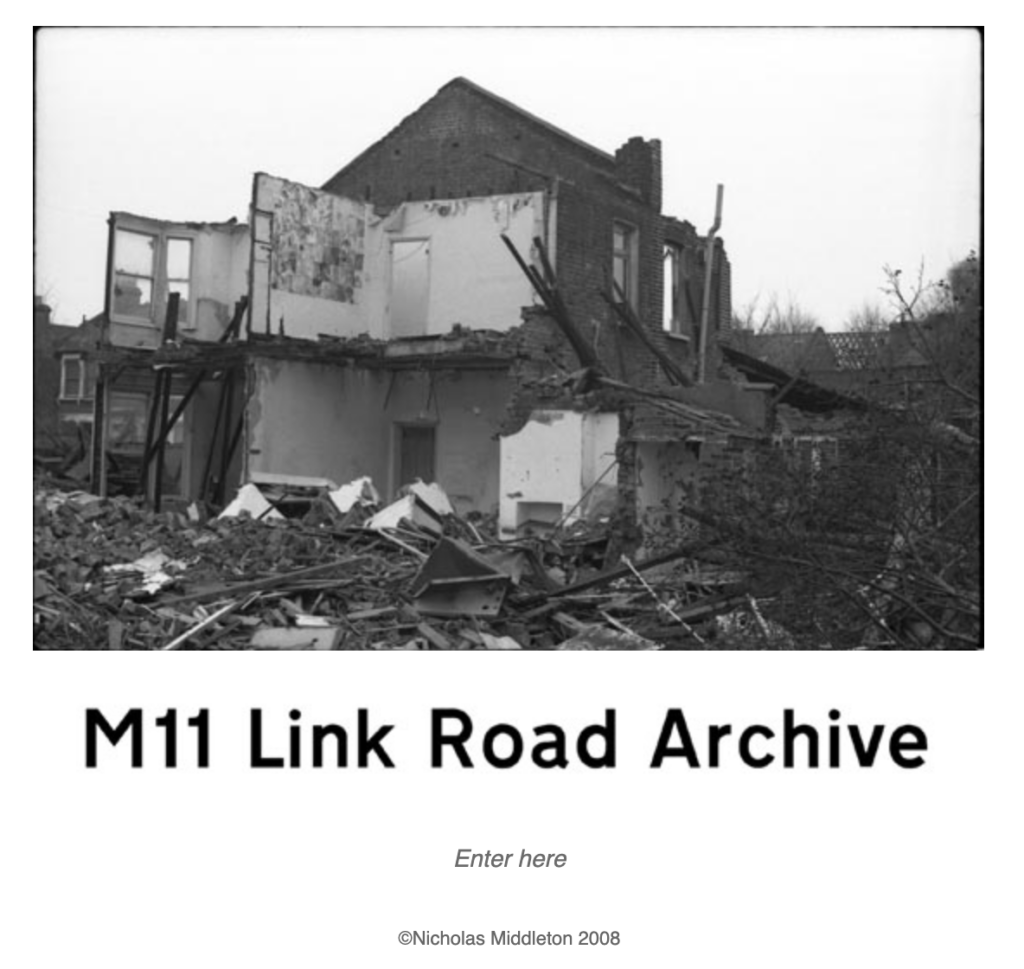The soundscape I created in the podcast was a homage to Graeme Miller’s ‘Linked’. You can find out more on the pages on the ArtsAdmin’s website.
Linked has now been taken down – but there will be opportunities later in the year to experience it for the very last time. Watch this space! You can find more out about the history of the M11 Link Road which demolished hundreds of people’s houses including Miller’s in the reading this week. There is something urgent in the process of something being erased that drives people to capture it in some way.
I met Graeme Miller in 2003 in the year ‘Linked’ launched and came home to tell my then partner about this fantastic sounding artwork in East London. In a weird coincidence – it turned out he had photographed that area at the time of all the demolitions and had this archive of photos that he’d taken as a young art student traveling in and out of London while studying on his foundation year. Here’s what he said to me when I asked if we could use the photos in this pack.
“Whenever I’d get the tube into London, going past particularly Claremont Road in Leyton, I’d see it was slowly changing. Housing blight was happening over a course of years with houses that emptied as they were bought up by the council and no one moved in to replace the old owners. Streets started looking dilapidated and no one wanted to buy around there. Graffiti everywhere – one that I always loved was ‘Why Bother’ on the back of one empty house. But suddenly it very quickly started to change – houses I’d been looking at the previous week on my way into art college – suddenly started disappearing as they were demolished. One day there’d be half a house and one week later it’d be gone. I started photographing buildings because they looked like my house where I’d grown up. This could have been our house. I started near my old school – it felt so incredibly close to me. It was tied up too with the sense of moral bankruptcy that was coming off the Tory Party. I thought this is what it would have been like post World War II, with houses disappearing overnight. With half a street gone. This is what bomb damage must have felt like.”
As a result of us digging out this archive and in the crossovers of being around my research, he met with academics at the London College of Communication that used his photos in a history of the protest and the area.* Somehow this moment in time that compelled Nick to capture it has become a reference and a resource. He has also created a number of paintings in response to these photos.*
This kind of compulsion is still at work in Nick and mine’s work. We are still making a film about London that we started nine years ago – partly moved to capture the Heygate Estate in South London that was being demolished. Some of the buildings in the film are no longer there.
Reading and Watching
Activities
Inside
1. Check out Nick’s photos capturing the demolition of the houses over time and his photo-realist paintings in response to them.
2. What image are you most drawn to?
3. Create a response to it – maybe you want to interview the people you can see in the photo? What would you ask them? Or maybe write a poem in response to it? Or maybe find a soundtrack to the photo? What song would you play alongside showing this photo to someone else? Any response you like is fine.
4. Make sure you’ve done the reading – which are examples of people inspired by building development to make artwork/do research – and once you have – you can now think about what might inspire you….
Outside
1. Is there anywhere where you live that you think is in the process of changing? Maybe something is being demolished? Maybe something is being built? Where is a space that means something to you that might be under threat of changing? Go and document it in any way you like. You might do a field recording.* You might film it. You might photograph it. You might write it.
2. Whatever artistic or creative practice that you think is appropriate for this space works.
*If you want to do this – jump ahead to the next page where I share the link to the free recording app again.



